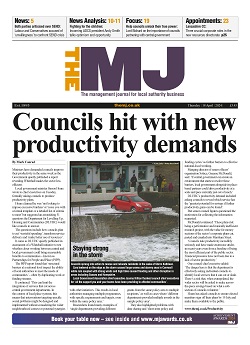Making sure labour supply is aligned to service demand can lead to big savings while protecting jobs, says Kevin White
The often quoted ‘more with less’ oxymoron goes to the heart of local authorities’ seemingly impossible task of meeting rising demand for services with a reducing budget.
Given the scale of the challenge posed, councils should look closely at working time – an area of their operations which has the key to unlock transformative efficiency, productivity and service gains.
For some, terms like ‘workforce optimisation’ and ‘flexible resourcing’ can be viewed as euphemisms for job losses and uncertainty.
However, the stark reality is that inefficient institutionalised working practices and inflexibility pose more of a long-term risk to jobs and service quality than any change to shift patterns.
In departments such as health, highways, street scene, CCTV or any service where demand fluctuates significantly, working time change projects can deliver annual savings of around 20%.
This is not snake oil or some overwrought IT project…at its heart lies the simple concept of ensuring labour supply remains completely aligned to service demand.
Mind the gap
The root cause of many workforce-related budget and service quality issues can be traced back to the gap that can open up between demand and supply.
Often legacy employment contracts ‘fix’ labour supply at a constant number of hours per day or per week across the year. In many departments this bears little relation to the peaks and troughs they experience in service demand over any given time frame.
Capacity shortfalls are usually dealt with through expensive overtime or agency staff. By contrast, in quieter periods departments can be over-staffed, leading to wasteful underutilisation.
Demand-led rostering tackles this by ensuring the workforce consistently matches the workload and is increasingly seen as the key to tackling resourcing challenges in the public and private sectors.
We’re not talking about insignificant or incremental gains either. Hundreds of millions of pounds of unnecessary inefficiencies are created every year by the gap between supply and demand.
A case in point is the NHS, where the £3.3bn spent on temporary workers in 2014 has become a central issue which has everyone from the regulator to the Prime Minister calling for changes to shift patterns.
Efficiency by design
By analysing and understanding service demand data a department can model the short, medium and long-term trends that exist.
Forecasting future requirements in this way provides a valid base from which to design patterns of labour supply which have the flexibility required to meet variability and volatility of demand.
When complete, this modelling unlocks a huge range of options to ensure that exactly the right level of resource is available to meet requirements.
For example, a two-man team can have 441 ways to allocate five day shifts per week…meaning that department-wide, there is more than enough options to cover any pattern of demand as well as build in necessary contingency.
In practical terms, local authorities can use software to purpose-build and manage rosters that eliminate under or over-provision, as well as protect against potential contractual or regulatory breaches.
This flexible way of resourcing delivers significant benefits for both the local authority and its employees.
One project we undertook for Cheshire West & Chester Council’s waste management and street scene department delivered savings of around 17% of its total budget in the first 12 months – principally through eliminating temporary staffing requirements.
Far from reducing headcount, the new working arrangements actually created new full-time roles needed to meet the demand that was previously being serviced by temporary labour.
For employees, the ability to customise their own shifts – within the defined parameters dictated by demand – is empowering. It enables teams to easily come up with co-created solutions that work for the department but also the individual and can be easily adapted to reflect changing needs.
Engage to succeed
Whilst the logic behind working time change is clear and the methodology is proven, the biggest barrier to adoption for local authorities is a cultural one.
Altering deeply engrained employment practices and legacy contracts can prove challenging without commitment from senior management to engage fully and work in conjunction with employees to deliver the necessary changes.
Employees’ concerns are understandable but entirely avoidable when the benefits of demand-led rostering are clearly communicated and staff are given the opportunity to collaborate in the design and implementation of new working practices.
Employees’ family lives are built around their working patterns so the benefits of creating rosters that are better aligned to their personal circumstances can have a dramatic impact on their wellbeing and quality of life.
For those local authorities embarking on working time change projects it is crucial that they focus on continuous improvement so that workforce optimisation delivers benefits no matter what the political, social or economic landscape.
Kevin White is managing director of Working Time Solutions, which provides workforce planning and management software and services

